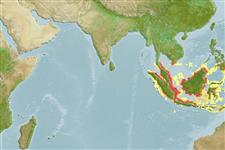Thryssa kammalensis (Bleeker, 1849)
Kammal thryssa
Beobachtung melden im Fish Watcher
| Native range | All suitable habitat | Point map | Year 2050 |

|
| This map was computer-generated and has not yet been reviewed. |
| Thryssa kammalensis AquaMaps Data sources: GBIF OBIS |
Hochladen Photos und videos
Pictures | Google BildThryssa kammalensis
Picture by Shao, K.T.
Pictures | Google BildThryssa kammalensis
Picture by Shao, K.T.
Klassifizierung / Names Namen | Synonyme | Catalog of Fishes(Gattung, Arten) | ITIS | CoL | WoRMS | Cloffa
> Clupeiformes (Herrings) > Engraulidae (Anchovies) > Coiliinae
Etymology: Thryssa: Greek, thrissa, -es = shad (Ref. 45335).
More on author: Bleeker.
Etymology: Thryssa: Greek, thrissa, -es = shad (Ref. 45335).
More on author: Bleeker.
Environment: milieu / climate zone / depth range / distribution range Ökologie
seewasser; brackwasser; ozeanodrom (Ref. 51243); tiefenbereich 1 - 20 m (Ref. 6898). Tropical; 9°N - 11°S, 94°E - 126°E (Ref. 189)
Verbreitung Länder | FAO Gebiete | Ecosystems | Vorkommen | Point map | Einführungen | Faunafri
Indo-West Pacific: only Penang, Malaysia in the Indian Ocean; southern Thailand to Singapore, southern Kalimantan, Java and Sulawesi. Records of this species from India refer to the rather similar Thryssa kammalensoides.
Size / Gewicht / Alter
Maturity: Lm ? range ? - ? cm
Max length : 18.0 cm TL Männchen/unbestimmt; (Ref. 125279); max. veröff. Gewicht: 36.50 g (Ref. 125279)
Max length : 18.0 cm TL Männchen/unbestimmt; (Ref. 125279); max. veröff. Gewicht: 36.50 g (Ref. 125279)
Kurzbeschreibung Bestimmungsschlüssel | Morphologie | Morphometrie
Rückenflossenstacheln (insgesamt) : 0; Afterflossenstacheln: 0; Afterflossenweichstrahlen: 30 - 33. Belly with 23 to 25 (rarely 24 or 26) keeled scutes from isthmus to anus. Maxilla moderate, reaching just to gill opening or a little beyond in large fishes; first supra-maxilla about half of second. A diffuse dark `saddle' on nape.
Presumably schooling and occurring mostly inshore. More data needed based on correct identifications.
Life cycle and mating behavior Geschlechtsreife | Fortpflanzung | Ablaichen | Eier | Fecundity | Larven
Hauptreferenz
Upload your references | Referenzen | Koordinator | Partner
Wongratana, T., T.A. Munroe and M. Nizinski, 1999. Order Clupeiformes. Engraulidae. Anchovies. p. 1698-1753. In K.E. Carpenter and V.H. Niem (eds.) FAO species identification guide for fishery purposes. The living marine resources of the WCP. Vol. 3. Batoid fishes, chimaeras and bony fishes part 1 (Elopidae to Linophrynidae). FAO, Rome. (Ref. 9822)
IUCN Rote Liste Status (Ref. 130435: Version 2024-2)
Daten mangelhaft (DD) ; Date assessed: 12 February 2018
CITES
Not Evaluated
Bedrohung für Menschen
Harmless
Nutzung durch Menschen
Fischereien: kleinfischerei
FAO - Publication: search | FishSource |
Mehr Information
Population dynamics
Growth parameters
Max. ages / sizes
Length-weight rel.
Length-length rel.
Längenhäufigkeiten
Mass conversion
Rekrutierung
Dichte
Growth parameters
Max. ages / sizes
Length-weight rel.
Length-length rel.
Längenhäufigkeiten
Mass conversion
Rekrutierung
Dichte
Life cycle
Fortpflanzung
Geschlechtsreife
Maturity/Gills rel.
Fecundity
Ablaichen
Spawning aggregations
Eier
Eientwicklung
Larven
Larven Pop.Dyn.
Fortpflanzung
Geschlechtsreife
Maturity/Gills rel.
Fecundity
Ablaichen
Spawning aggregations
Eier
Eientwicklung
Larven
Larven Pop.Dyn.
Physiology
Body composition
Nutrients
Oxygen consumption
Swimming type
Swimming speed
Visual pigments
Fish sound
Diseases & Parasites
Toxicity (LC50s)
Body composition
Nutrients
Oxygen consumption
Swimming type
Swimming speed
Visual pigments
Fish sound
Diseases & Parasites
Toxicity (LC50s)
Genetics
Genetik
Heterozygosity
Vererbbarkeit
Genetik
Heterozygosity
Vererbbarkeit
Human related
Aquaculture systems
Aquakultur Profile
Zuchtlinien
Ciguatera cases
Stamps, coins, misc.
Aquaculture systems
Aquakultur Profile
Zuchtlinien
Ciguatera cases
Stamps, coins, misc.
Tools
E-book | Feldführer | Bestimmungsschlüssel | Längenhäufigkeits Tool | Lebensdaten Tool | Punkt Karte | Classification Tree
| Catch-MSY |
Zusatzinformationen
Download XML
Zusammenfassung | Point data | Namen | Photos
Internet Quellen
AFORO (otoliths) | Aquatic Commons | BHL | Cloffa | BOLDSystems | Websites from users | FishWatcher Einträge suchen | CISTI | Catalog of Fishes: Gattung, Arten | DiscoverLife | ECOTOX | FAO - Publication: search | Faunafri | Fishipedia | Fishtrace | GenBank: Genom, nucleotide | GloBI | Google Books | Google Scholar | Google | IGFA World Record | MitoFish | Nationale Datenbanken | Otolith Atlas of Taiwan Fishes | PubMed | Reef Life Survey | Socotra Atlas | Tree of Life | Wikipedia: Gehe zu, Suchen | World Records Freshwater Fishing | Zoological Record
Estimates based on models
Preferred temperature (Ref. 123201): 28.4 - 29.4, mean 29 °C (based on 536 cells).
Phylogenetic diversity index (Ref. 82804): PD50 = 0.5000 [Uniqueness, from 0.5 = low to 2.0 = high].
Bayesian length-weight: a=0.00501 (0.00365 - 0.00689), b=3.13 (3.07 - 3.19), in cm total length, based on LWR estimates for this species (Ref. 93245).
Trophic level (Ref. 69278): 3.4 ±0.4 se; based on diet studies.
Generation time: 3.3 ( na - na) years. Estimated as median ln(3)/K based on 1 growth studies.
Widerstandsfähigkeit (Ref. 120179): mittel, Verdopplung der Population dauert 1,4 - 4,4 Jahre. (Preliminary K or Fecundity.).
Fishing Vulnerability (Ref. 59153): Low to moderate vulnerability (32 of 100).




